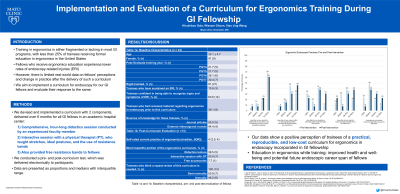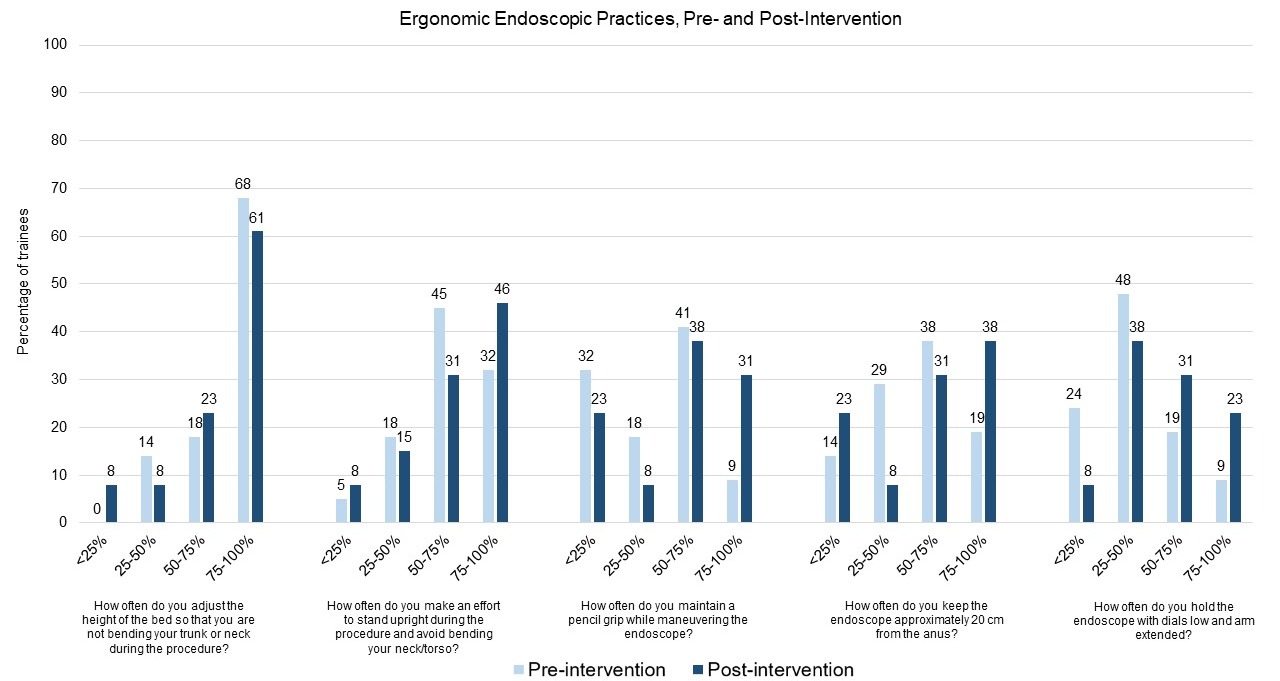Tuesday Poster Session
Category: Practice Management
P4065 - Implementation and Evaluation of a Curriculum for Ergonomics Training During GI Fellowship
Tuesday, October 24, 2023
10:30 AM - 4:00 PM PT
Location: Exhibit Hall

Has Audio

Khushboo Gala, MBBS
Fellow
Mayo Clinic, Rochester
Rochester, MN
Presenting Author(s)
Khushboo Gala, MBBS, Wissam Ghusn, MD, Xiao Jing Wang, MD
Mayo Clinic, Rochester, MN
Introduction: Training in ergonomics is either fragmented or lacking in most GI programs, with less than 25% of trainees receiving formal education in ergonomics in the United States. Fellows who receive ergonomics education experience lower rates of endoscopy-related injuries (ERI). However, there is limited real-world data on fellows’ perceptions and change in practice after the delivery of such a curriculum. We aim to implement a curriculum for endoscopy for our GI fellows and evaluate their response to the same.
Methods: Training in ergonomics is either fragmented or lacking in most GI programs, with less than 25% of trainees receiving formal education in ergonomics in the United States. Fellows who receive ergonomics education experience lower rates of endoscopy-related injuries (ERI). However, there is limited real-world data on fellows’ perceptions and change in practice after the delivery of such a curriculum. We aim to implement a curriculum for endoscopy for our GI fellows and evaluate their response to the same.
Results: We surveyed 23 fellows (post-graduate year 4-7), with a mean age of 33 ± 4.7 years, 41% female and 91% right-handed (Table 1a). At baseline, 13.6% (3) had sustained ERI during their training. Only 63.6% (14) of trainees reported confidence in being able to recognize signs and symptoms of ERI. Their median self-reported understanding of ergonomics was 3 on a Likert scale of 1-5, corresponding with “average understanding”. The majority of trainees had never reviewed any material on ergonomics prior to this curriculum. Thirteen fellows completed the post-test (Table 1b). Their median self-reported understanding of ergonomics improved to 4 on a Likert scale of 1-5, corresponding with “above average understanding”. The majority of fellows felt that the interactive session with PT was the most impactful portion of the curriculum. Fellows were asked about specific endoscopic practices in the pre-and post-test (Figure 1). Most practices were more consistently followed by fellows after the curriculum. All fellows requested a repeat of the curriculum, either semi-annually or annually.
Discussion: Our data show a positive perception of trainees of a practical, reproducible, and low-cost curriculum for endoscopy incorporated during GI fellowship. Education in ergonomics while training has been shown to lead to improved health and well-being, and may lead to potentially improved future endoscopic career span of fellows.

Disclosures:
Khushboo Gala, MBBS, Wissam Ghusn, MD, Xiao Jing Wang, MD. P4065 - Implementation and Evaluation of a Curriculum for Ergonomics Training During GI Fellowship, ACG 2023 Annual Scientific Meeting Abstracts. Vancouver, BC, Canada: American College of Gastroenterology.
Mayo Clinic, Rochester, MN
Introduction: Training in ergonomics is either fragmented or lacking in most GI programs, with less than 25% of trainees receiving formal education in ergonomics in the United States. Fellows who receive ergonomics education experience lower rates of endoscopy-related injuries (ERI). However, there is limited real-world data on fellows’ perceptions and change in practice after the delivery of such a curriculum. We aim to implement a curriculum for endoscopy for our GI fellows and evaluate their response to the same.
Methods: Training in ergonomics is either fragmented or lacking in most GI programs, with less than 25% of trainees receiving formal education in ergonomics in the United States. Fellows who receive ergonomics education experience lower rates of endoscopy-related injuries (ERI). However, there is limited real-world data on fellows’ perceptions and change in practice after the delivery of such a curriculum. We aim to implement a curriculum for endoscopy for our GI fellows and evaluate their response to the same.
Results: We surveyed 23 fellows (post-graduate year 4-7), with a mean age of 33 ± 4.7 years, 41% female and 91% right-handed (Table 1a). At baseline, 13.6% (3) had sustained ERI during their training. Only 63.6% (14) of trainees reported confidence in being able to recognize signs and symptoms of ERI. Their median self-reported understanding of ergonomics was 3 on a Likert scale of 1-5, corresponding with “average understanding”. The majority of trainees had never reviewed any material on ergonomics prior to this curriculum. Thirteen fellows completed the post-test (Table 1b). Their median self-reported understanding of ergonomics improved to 4 on a Likert scale of 1-5, corresponding with “above average understanding”. The majority of fellows felt that the interactive session with PT was the most impactful portion of the curriculum. Fellows were asked about specific endoscopic practices in the pre-and post-test (Figure 1). Most practices were more consistently followed by fellows after the curriculum. All fellows requested a repeat of the curriculum, either semi-annually or annually.
Discussion: Our data show a positive perception of trainees of a practical, reproducible, and low-cost curriculum for endoscopy incorporated during GI fellowship. Education in ergonomics while training has been shown to lead to improved health and well-being, and may lead to potentially improved future endoscopic career span of fellows.

Figure: Ergonomic Endoscopy Practices, Pre- and Post-Curriculum
Disclosures:
Khushboo Gala indicated no relevant financial relationships.
Wissam Ghusn indicated no relevant financial relationships.
Xiao Jing Wang indicated no relevant financial relationships.
Khushboo Gala, MBBS, Wissam Ghusn, MD, Xiao Jing Wang, MD. P4065 - Implementation and Evaluation of a Curriculum for Ergonomics Training During GI Fellowship, ACG 2023 Annual Scientific Meeting Abstracts. Vancouver, BC, Canada: American College of Gastroenterology.
